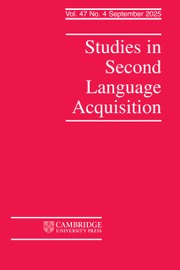Article contents
PRACTICE IS IMPORTANT BUT HOW ABOUT ITS QUALITY?
CONTEXTUALIZED PRACTICE IN THE CLASSROOM
Published online by Cambridge University Press: 25 April 2019
Abstract
This study explored the impact of contextualized practice on second language (L2) learners’ production of wh-questions in the L2 classroom. It examined the quality of practice (correct vs. incorrect production) and the contribution of declarative knowledge to proceduralization. Thirty-four university-level English as a foreign language learners first completed a declarative knowledge test. Then, they engaged in various communicative activities over five weeks. Their production of wh-questions was coded for accuracy (absence of errors) and fluency (speech rate, mean length of pauses, and repair phenomena). Improvement was measured as the difference between the first and last practice sessions. The results showed that accuracy, speech rate, and pauses improved but with distinct patterns. Regression models showed that declarative knowledge did not predict accuracy or fluency; however, declarative knowledge assisted the learners to engage in targetlike behaviors at the initial stage of proceduralization. Furthermore, whereas production of accurate wh-questions predicted accuracy improvement, it had no impact on fluency.
Information
- Type
- Research Article
- Information
- Open Practices
Open materials
- Copyright
- Copyright © Cambridge University Press 2019
Footnotes
This work was partially supported by grants awarded to the first author by the Fondo Nacional de Desarrollo Científico y Tecnólogico from the Ministry of Education of Chile (FONDECYT: 1181533) and PIA (CIE160009) from the Chilean National Commission of Science and Technology (CONICYT) as well as funding awarded to the second author from the Canada Research Chairs program (950-231218).
The experiment in this article earned an Open Materials badge for transparent practices. The materials are available at https://www.iris-database.org/iris/app/home/detail?id=york%3a936167.
We would like to thank the teachers who generously supported our project and the research assistants who helped with data collection and coding: Mayuri Kewlani, Estefanía Valencia, Camila Valenzuela, Mélanie Vergara, and Paula Viveros.
References
REFERENCES
- 26
- Cited by

